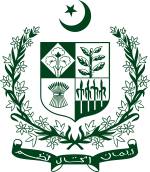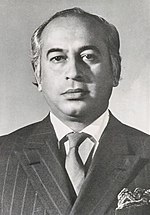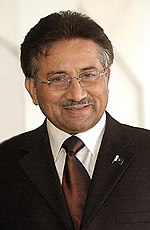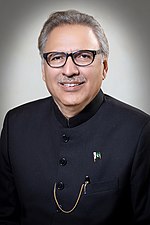President of Pakistan
| President of the Islamic Republic of Pakistan
صدر مملکت اسلامی جمہوریہ پاکستان | |
|---|---|
 | |
| Style | Mr. President (informal) Honourable President or His Excellency |
| Type | Head of state (Ceremonial) |
| Residence | Aiwan-e-Sadr |
| Seat | Islamabad |
| Appointer | Electoral College |
| Term length | Five years Renewable once |
| Constituting instrument | Constitution of Pakistan |
| Precursor | Governor General of Pakistan |
| Inaugural holder | Iskandar Mirza |
| Formation | March 23, 1956 |
| Deputy | abolished, Vice President of Pakistan |
| Salary | Rs 846,550 per month[1][2] |
| Website | President of Pakistan |
 |
|---|
| This article is part of a series on the politics and government of Pakistan |
The president of Pakistan (Urdu: صدر, Sadr-e-Mumlikat) is the head of state of Pakistan. Pakistan has a parliamentary form of government. According to the Constitution, the President is chosen by the Electoral College to serve a five-year term. The electoral college is made up of the Senate, National Assembly, and the provincial assemblies.[3]
The position of president in Pakistan has usually been one of a figurehead. That is with real power being given to the Prime Minister. However the power of the president has changed over the years, due to the military changing the role.
History
[change | change source]In 1947, Pakistan became a dominion and part of the British Commonwealth with the British Monarch as head of state, represented by the Governor-General of Pakistan. In 1956 Pakistan established its first constitution and became a Republic, and the Queen and Governor-General were replaced by the president.
Pakistan's first president was Iskander Mirza, who was also the last Governor General. In 1958, he removed the constitution and declared martial law. A few weeks later, he was overthrown by General Ayub Khan, who then declared himself president. The constitution was changed and the president became the ruler of Pakistan. The constitution also said that the president be elected by the people. Elections were held in 1963, and Khan defeated Fatima Jinnah, sister of founder of Pakistan, Muhammad Ali Jinnah.
List of presidents of Pakistan
[change | change source]| Party name | |
|---|---|
| Republican Party | |
| Muslim League (C) | |
| Armed Forces | |
| Independent | |
| Muslim League (Q) | |
| Peoples Party | |
| Muslim League (N) | |
| Pakistan Tehreek-e-Insaf |
List of presidents of Pakistan
[change | change source]| No | Portrait | Name (Birth–Death) |
Elections | Took office | Left office | Political party | Note |
|---|---|---|---|---|---|---|---|
| 1 | 
|
Iskander Mirza (1899–1969) |
1958 Pakistani coup d'état | 23 March 1956 | 27 October 1958 | Republican Party | |
| 2 | 
|
Ayub Khan (1907–1974) | 1958 Pakistani coup d'état | 27 October 1958 | 8 June 1962 | Military Dictator | |
| (2) | 2 January 1965 | 8 June 1962 | 29 November 1963 | Military Dictator Pakistan Muslim League (C) | |||
| — | 
|
Mohammad Afzal Cheema (1913–2008) Acting |
— | 1962 | 1963 | Senior Deputy Speaker of the National Assembly 1962-1965 | |
| — | 
|
Fazlul Qadir Chaudhry (1919–1973) Acting |
— | 29 November 1963 | 12 June 1965 | Pakistan Muslim League (C) | |
| (2) | 
|
Ayub Khan (1907–1974) |
2 January 1965 | 12 June 1965 | 31 March 1969 | Pakistan Muslim League (C) | |
| 3 | 
|
Yahya Khan (1917–1980) |
—Military Dictator | 31 March 1969 | 20 December 1971 | Military Dictator | |
| 4 | 
|
Zulfikar Ali Bhutto (1928–1979) |
20 December 1971 | 20 December 1971 | 13 August 1973 | Pakistan Peoples Party | |
| 5 | 
|
Fazal Ilahi Chaudhry (1904–1982) |
14 August 1973 | 14 August 1973 | 20 April 1978 | Pakistan Peoples Party | |
| — | 
|
Sheikh Anwarul Haq (1917–1995) Acting |
14 August 1973 | 20 April 1978 | 7 May 1978 | Pakistan Peoples Party | |
| (5) | 
|
Fazal Ilahi Chaudhry (1904–1982) |
14 August 1973 | 7 May 1978 | 16 September 1978 | Pakistan Peoples Party | |
| 6 | Muhammad Zia-ul-Haq (1924–1988) |
Military Dictator | 16 September 1978 | 17 August 1988 | Military Dictator | ||
| 7 | 
|
Ghulam Ishaq Khan (1915–2006) |
13 December 1988 | 17 August 1988 | 18 July 1993 | Independent | |
| — | 
|
Wasim Sajjad (1941– ) Acting |
1995 Pakistani coup d'état attempt | 18 July 1993 | 14 November 1993 | Pakistan Muslim League (N) | |
| 8 | 
|
Farooq Leghari (1940–2010) |
14 November 1993 | 14 November 1993 | 2 December 1997 | Pakistan Peoples Party | |
| — | 
|
Wasim Sajjad (1941– ) Acting |
— | 27 December 1997 | 1 January 1998 | Pakistan Muslim League (N) | |
| 9 | 
|
Muhammad Rafiq Tarar (1929–2022) |
31 December 1997 1999 Pakistani coup d'état | 1 January 1998 | 20 June 2001 | Pakistan Muslim League (N) | |
| 10 | 
|
Pervez Musharraf (1943–2023) |
Military Dictator | 20 June 2001 | 6 October 2007 | 1 January 2004[n 1] | |
| (10) | 6 October 2007 | 6 October 2007 | 18 August 2008 | Military Dictator Pakistan Muslim League (Q) | |||
| — | 
|
Muhammad Mian Soomro (1950– ) Acting |
— | 18 August 2008 | 9 September 2008 | Pakistan Muslim League (N) | |
| 11 | 
|
Asif Ali Zardari (1955– ) |
6 September 2008 | 9 September 2008 | 9 September 2013 | Pakistan Peoples Party | |
| 12 | 
|
Mamnoon Hussain (1940–2021) |
30 July 2013 | 9 September 2013 | 9 September 2018 | Pakistan Muslim League (N) | |
| 13 | 
|
Arif Alvi (1949– ) |
4 September 2018 | 9 September 2018 | 10 March 2024 | Pakistan Tehreek-e-Insaf | |
| (11) | 
|
Asif Ali Zardari (1955– ) |
9 March 2024 | 10 March 2024 | Incumbent | Pakistan Peoples Party |
Living former presidents
[change | change source]- Living former presidents
Present holder of the post
[change | change source]The President is now Arif Alvi, a former dentist. He has been a member of the National Assembly of Pakistan since August 2018. Before, he was a member of the National Assembly from June 2013 to May 2018. He is a member of Pakistan Tehreek-e-Insaf, a moderate Party with democratic ideals.
Notes
[change | change source]References
[change | change source]- ↑ "Govt wants to double president's salary". The Express Tribune. 29 May 2018.
- ↑ "Data" (PDF). www.na.gov.pk. Retrieved 2020-06-09.
- ↑ "President of Pakistan: Official Website". Archived from the original on 2008-07-05. Retrieved 2021-04-27.
- ↑ Waldman, Amy (2 January 2004). "Pakistan gives Musharraf confidence vote as president". The New York Times. Retrieved 20 January 2013.

